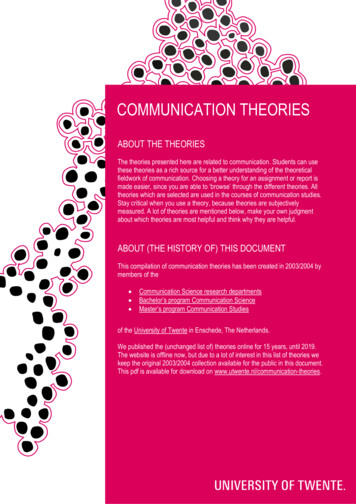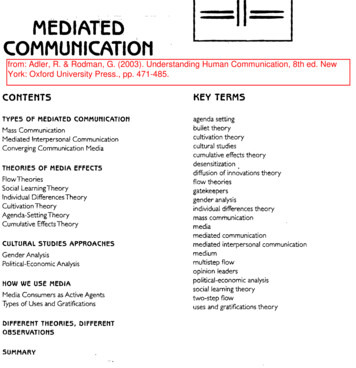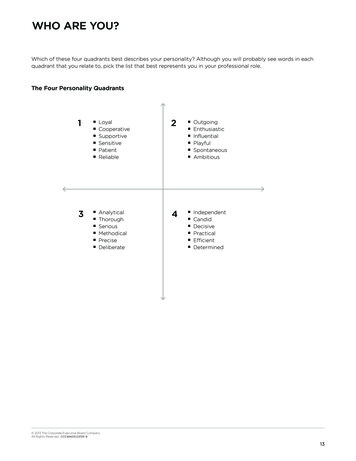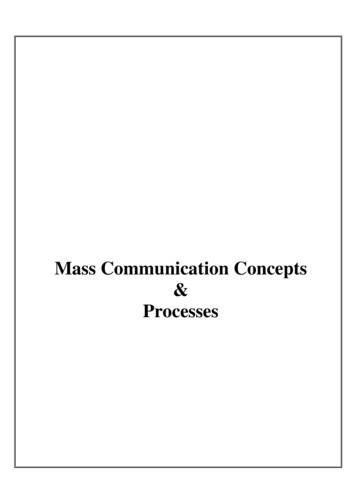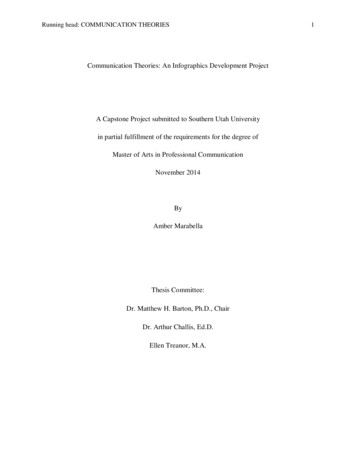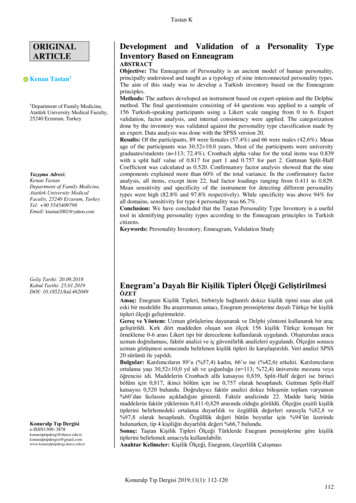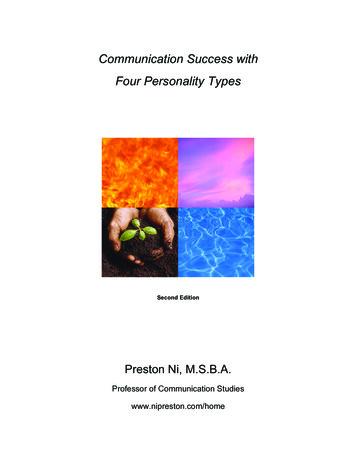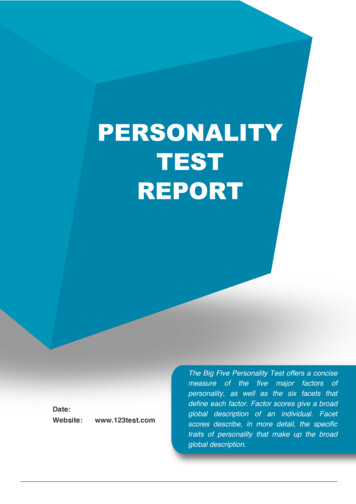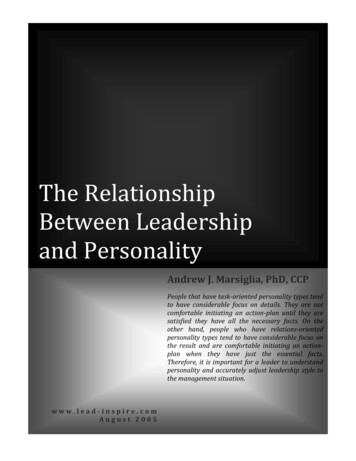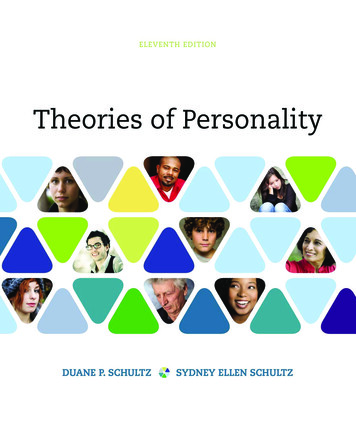
Transcription
5 REASONSto buy your textbooksand course materials at1SAVINGS:2CHOICE:3CONVENIENCE:45Prices up to 75% off, daily coupons, and free shipping on orders over 25Multiple format options including textbook, eBook and eChapter rentalsAnytime, anywhere access of eBooks or eChapters via mobile devicesSERVICE:Free eBook access while your text ships, and instant access to online homework productsSTUDY TOOLS:Study tools* for your text, plus writing, research, career and job search resources*availability variesFind your course materials and start saving at:www.cengagebrain.comSource Code: 14M-AA0107Engaged with you.www.cengage.comCopyright 2017 Cengage Learning. All Rights Reserved. May not be copied, scanned, or duplicated, in whole or in part. Due to electronic rights, some third party content may be suppressed from the eBook and/or eChapter(s).Editorial review has deemed that any suppressed content does not materially affect the overall learning experience. Cengage Learning reserves the right to remove additional content at any time if subsequent rights restrictions require it.
Theories of PersonalityCopyright 2017 Cengage Learning. All Rights Reserved. May not be copied, scanned, or duplicated, in whole or in part. Due to electronic rights, some third party content may be suppressed from the eBook and/or eChapter(s).Editorial review has deemed that any suppressed content does not materially affect the overall learning experience. Cengage Learning reserves the right to remove additional content at any time if subsequent rights restrictions require it.
Copyright 2017 Cengage Learning. All Rights Reserved. May not be copied, scanned, or duplicated, in whole or in part. Due to electronic rights, some third party content may be suppressed from the eBook and/or eChapter(s).Editorial review has deemed that any suppressed content does not materially affect the overall learning experience. Cengage Learning reserves the right to remove additional content at any time if subsequent rights restrictions require it.
ELEVENTH EDITIONTheories of PersonalityDUANE P . SCHULTZUniversity of South FloridaSYDNEY ELLEN SCHULTZAustralia Brazil Mexico Singapore United Kingdom United StatesCopyright 2017 Cengage Learning. All Rights Reserved. May not be copied, scanned, or duplicated, in whole or in part. Due to electronic rights, some third party content may be suppressed from the eBook and/or eChapter(s).Editorial review has deemed that any suppressed content does not materially affect the overall learning experience. Cengage Learning reserves the right to remove additional content at any time if subsequent rights restrictions require it.
This is an electronic version of the print textbook. Due to electronic rights restrictions, some third party content may be suppressed. Editorialreview has deemed that any suppressed content does not materially affect the overall learning experience. The publisher reserves the right toremove content from this title at any time if subsequent rights restrictions require it. For valuable information on pricing, previouseditions, changes to current editions, and alternate formats, please visit www.cengage.com/highered to search byISBN#, author, title, or keyword for materials in your areas of interest.Important Notice: Media content referenced within the product description or the product text may not be available in the eBook version.Copyright 2017 Cengage Learning. All Rights Reserved. May not be copied, scanned, or duplicated, in whole or in part. Due to electronic rights, some third party content may be suppressed from the eBook and/or eChapter(s).Editorial review has deemed that any suppressed content does not materially affect the overall learning experience. Cengage Learning reserves the right to remove additional content at any time if subsequent rights restrictions require it.
Theories of Personality, Eleventh EditionDuane P. Schultz andSydney Ellen SchultzProduct Director: Jon-David HagueContent Developer: Michelle ClarkProduct Assistant: Kimiya HojjatMarketing Manager: Melissa LarmonArt and Cover Direction, ProductionManagement, and Composition:Lumina Datamatics, Inc.Manufacturing Planner: Karen HuntCover Image: Alan Bailey/Shutterstock; Rusian Guzov/Shutterstock; sianc/Shutterstock, Jochen Schoenfeld/Shutterstock, Konstantin Sutyagin/Shutterstock; PT Images/Shutterstock; JasonStitt/Shutterstock; beboy/Shutterstock; TalyaPhoto/Shutterstock; knikola/ShutterstockUnless otherwise noted all items Cengage Learning 2017, 2013 Cengage LearningWCN: 02-200-203ALL RIGHTS RESERVED. No part of this work covered by the copyrightherein may be reproduced or distributed in any form or by any means,except as permitted by U.S. copyright law, without the prior writtenpermission of the copyright owner.For product information and technology assistance, contact us atCengage Learning Customer & Sales Support, 1-800-354-9706.For permission to use material from this text or product, submit allrequests online at www.cengage.com/permissions.Further permissions questions can be e-mailed topermissionrequest@cengage.com.Library of Congress Control Number: 2015915554Student Edition:ISBN: 978-1-305-65295-8Cengage Learning20 Channel Center StreetBoston, MA 02210USACengage Learning is a leading provider of customized learningsolutions with employees residing in nearly 40 different countriesand sales in more than 125 countries around the world. Find your localrepresentative at www.cengage.com.Cengage Learning products are represented in Canada byNelson Education, Ltd.To learn more about Cengage Learning Solutions, visitwww.cengage.com.Purchase any of our products at your local college store or at ourpreferred online store www.cengagebrain.com.Printed in the United States of AmericaPrint Number: 01Print Year: 2015Copyright 2017 Cengage Learning. All Rights Reserved. May not be copied, scanned, or duplicated, in whole or in part. Due to electronic rights, some third party content may be suppressed from the eBook and/or eChapter(s).Editorial review has deemed that any suppressed content does not materially affect the overall learning experience. Cengage Learning reserves the right to remove additional content at any time if subsequent rights restrictions require it.
brief ContentsPrefaceCHAPTER1xiiiPersonality: What It Is and Why You Should Care1The Psychoanalytic Approach 35CHAPTER2Sigmund Freud: Psychoanalysis37The Neo-psychoanalytic Approach79CHAPTER3Carl Jung: Analytical PsychologyCHAPTER4Alfred Adler: Individual PsychologyCHAPTER5Karen Horney: Neurotic Needs and TrendsThe Life-Span ApproachCHAPTER6Erik Erikson: Identity Theory81108135157159The Genetics Approach 191CHAPTER7Gordon Allport: Motivation and PersonalityCHAPTER8Raymond Cattell, Hans Eysenck, the Five-Factor Theory, HEXACO,and the Dark Triad 213The Humanistic ApproachCHAPTER9CHAPTER10CHAPTER11Carl Rogers: Self-Actualization Theory12247271291George Kelly: Personal Construct TheoryThe Behavioral ApproachCHAPTER245Abraham Maslow: Needs-Hierarchy TheoryThe Cognitive Approach193293315B. F. Skinner: Reinforcement Theory317The Social-Learning Approach 339CHAPTER13Albert Bandura: Modeling Theory341vCopyright 2017 Cengage Learning. All Rights Reserved. May not be copied, scanned, or duplicated, in whole or in part. Due to electronic rights, some third party content may be suppressed from the eBook and/or eChapter(s).Editorial review has deemed that any suppressed content does not materially affect the overall learning experience. Cengage Learning reserves the right to remove additional content at any time if subsequent rights restrictions require it.
vi Brief ContentsThe Limited-Domain Approach369CHAPTER14Facets of Personality: Taking Control, Taking Chances, and FindingHappiness 371CHAPTER15Personality in Perspective407Glossary 419References 425Author Index 475Subject Index 492Copyright 2017 Cengage Learning. All Rights Reserved. May not be copied, scanned, or duplicated, in whole or in part. Due to electronic rights, some third party content may be suppressed from the eBook and/or eChapter(s).Editorial review has deemed that any suppressed content does not materially affect the overall learning experience. Cengage Learning reserves the right to remove additional content at any time if subsequent rights restrictions require it.
contentsPrefaceCHAPTER1xiiiPersonality: What It Is and Why You Should CareTake a Look at the Word1Research in the Study of Personality24The Role of Theory in Personality Theories29Questions about Human Nature: What Are We Like?Chapter Summary33Review Questions33Suggested Readings2Sigmund Freud: PsychoanalysisThe Life of Freud (1856–1939)Freud Comes to AmericaThe Final Years3537384242Instincts: The Propelling Forces of the PersonalityThe Levels of PersonalityAnxiety: A Threat to the EgoDefenses against Anxiety454749Psychosexual Stages of Personality DevelopmentQuestions about Human Nature58Criticisms of Freud’s Research60Extensions of Freudian Theory73Reflections on Freud’s Theory76Review Questions77Suggested Readings7478The Neo-psychoanalytic Approach3Carl Jung: Analytical PsychologyThe Life of Jung (1875–1961)798182Psychic Energy: The Basis of Jung’s SystemAspects of Personality5157Assessment in Freud’s TheoryChapter Summary4344The Structure of PersonalityCHAPTER3134The Psychoanalytic ApproachCHAPTER18687The Development of the PersonalityQuestions about Human Nature9396viiCopyright 2017 Cengage Learning. All Rights Reserved. May not be copied, scanned, or duplicated, in whole or in part. Due to electronic rights, some third party content may be suppressed from the eBook and/or eChapter(s).Editorial review has deemed that any suppressed content does not materially affect the overall learning experience. Cengage Learning reserves the right to remove additional content at any time if subsequent rights restrictions require it.
viiiContentsAssessment in Jung’s TheoryResearch on Jung’s Theory97100Reflections on Jung’s TheoryChapter Summary106Review Questions106Suggested ReadingsCHAPTER4105107Alfred Adler: Individual PsychologyThe Life of Adler (1870–1937)108109Inferiority Feelings: The Source of All Human StrivingStriving for Superiority, or PerfectionThe Style of LifeSocial InterestBirth Order114116117Questions about Human Nature120Assessment in Adler’s TheoryResearch on Adler’s Theory120123Reflections on Adler’s TheoryChapter Summary133Review Questions133Suggested ReadingsCHAPTER5130134136The Childhood Need for Safety and SecurityBasic Anxiety: The Foundation of NeurosisNeurotic Needs139140141The Idealized Self-ImageFeminine Psychology145146Questions about Human Nature149Assessment in Horney’s TheoryResearch on Horney’s Theory150151Reflections on Horney’s TheoryChapter Summary154Review Questions155Suggested Readings6135Karen Horney: Neurotic Needs and TrendsThe Life of Horney (1885–1952)CHAPTER111113153155The Life-Span Approach157Erik Erikson: Identity Theory159The Life of Erikson (1902–1994)160Psychosocial Stages of Personality DevelopmentBasic Weaknesses162170Questions about Human NatureAssessment in Erikson’s TheoryResearch on Erikson’s Theory170171172Copyright 2017 Cengage Learning. All Rights Reserved. May not be copied, scanned, or duplicated, in whole or in part. Due to electronic rights, some third party content may be suppressed from the eBook and/or eChapter(s).Editorial review has deemed that any suppressed content does not materially affect the overall learning experience. Cengage Learning reserves the right to remove additional content at any time if subsequent rights restrictions require it.
Contents ixReflections on Erikson’s TheoryChapter Summary189Review Questions189Suggested Readings188190191The Genetics ApproachCHAPTER7Gordon Allport: Motivation and Personality193Allport Brings Personality into the Classroom and the Psychology LabThe Life of Allport (1897–1967)The Nature of PersonalityPersonality Traits196197Motivation: What We Strive for198Personality Development in Childhood: The Unique SelfThe Healthy Adult PersonalityAssessment in Allport’s Theory205Reflections on Allport’s Theory211Review Questions211CHAPTER8203204Research on Allport’s TheoryChapter Summary200202Questions about Human NatureSuggested Readings193194210212Raymond Cattell, Hans Eysenck, the Five-Factor Theory, HEXACO,and the Dark Triad 213Predicting Behavior214The Life of Cattell (1905–1998)214Cattell’s Approach to Personality Traits216Source Traits: The Basic Factors of PersonalityDynamic Traits: The Motivating ForcesStages of Personality DevelopmentQuestions about Human NatureAssessment in Cattell’s TheoryResearch on Cattell’s Theory219221222223Reflections on Cattell’s TheoryBehavioral Genetics218219225226Hans Eysenck (1916–1997)226The Dimensions of Personality226Robert McCrae and Paul Costa: The Five-Factor Model230Michael Ashton and Kibeom Lee: HEXACO: The Six-Factor Model239Delroy Paulhus and Kevin Williams: The Dark Triad ofPersonality 240Personality Traits and the Internet241Reflections on the Trait Approach242Chapter Summary242Copyright 2017 Cengage Learning. All Rights Reserved. May not be copied, scanned, or duplicated, in whole or in part. Due to electronic rights, some third party content may be suppressed from the eBook and/or eChapter(s).Editorial review has deemed that any suppressed content does not materially affect the overall learning experience. Cengage Learning reserves the right to remove additional content at any time if subsequent rights restrictions require it.
xContentsReview QuestionsSuggested Readings243243245The Humanistic ApproachCHAPTER9247Abraham Maslow: Needs-Hierarchy TheoryThe Life of Maslow (1908–1970)248Personality Development: The Hierarchy of NeedsThe Study of Self-Actualizers255Questions about Human Nature260Assessment in Maslow’s Theory261Research on Maslow’s Theory262Reflections on Maslow’s TheoryChapter Summary239Review Questions270Suggested ReadingsCHAPTER10238270271Carl Rogers: Self-Actualization TheoryThe Life of Rogers (1902–1987)272The Self and the Tendency toward ActualizationThe Experiential World276Characteristics of Fully Functioning PersonsQuestions about Human NatureResearch on Rogers’s Theory282283Reflections on Rogers’s Theory289Review Questions289288290291The Cognitive ApproachCHAPTER11279281Assessment in Rogers’s TheoryChapter SummaryGeorge Kelly: Personal Construct TheoryThe Cognitive Movement in PsychologyThe Life of Kelly (1905–1967)Personal Construct Theory295Questions about Human NatureAssessment in Kelly’s TheoryResearch on Kelly’s TheoryReflections on Kelly’s TheoryChapter Summary313Review Questions313293293297Ways of Anticipating Life EventsSuggested Readings274276The Development of the Self in ChildhoodSuggested Readings250398304304308312314Copyright 2017 Cengage Learning. All Rights Reserved. May not be copied, scanned, or duplicated, in whole or in part. Due to electronic rights, some third party content may be suppressed from the eBook and/or eChapter(s).Editorial review has deemed that any suppressed content does not materially affect the overall learning experience. Cengage Learning reserves the right to remove additional content at any time if subsequent rights restrictions require it.
Contents xiThe Behavioral ApproachCHAPTER12315317B. F. Skinner: Reinforcement TheoryRats, Pigeons, and an Empty OrganismThe Life of Skinner (1904–1990)317318Reinforcement: The Basis of Behavior321Operant Conditioning and the Skinner BoxSchedules of ReinforcementThe Shaping of BehaviorSuperstitious Behavior326328The Self-Control of Behavior329Applications of Operant ConditioningQuestions about Human Nature332Assessment in Skinner’s Theory333Research on Skinner’s Theory337Review Questions337Suggested Readings330334Reflections on Skinner’s TheoryChapter Summary335338339The Social-Learning ApproachCHAPTER13323324341Albert Bandura: Modeling TheoryThe Life of Bandura (1925–)342Modeling: The Basis of Observational LearningThe Processes of Observational LearningSelf-Reinforcement and Self-EfficacyDevelopmental Stages of Self-EfficacyBehavior ModificationAssessment in Bandura’s TheoryResearch on Bandura’s TheoryReflections on Bandura’s Theory367Review Questions368Suggested Readings350353354Questions about Human NatureChapter Summary357357357366368The Limited-Domain ApproachCHAPTER14343348369Facets of Personality: Taking Control, Taking Chances, and FindingHappiness 371Julian Rotter: Locus of Control372Marvin Zuckerman: Sensation Seeking378Martin E. P. Seligman: Learned Helplessness and the Optimistic/PessimisticExplanatory Style 385Copyright 2017 Cengage Learning. All Rights Reserved. May not be copied, scanned, or duplicated, in whole or in part. Due to electronic rights, some third party content may be suppressed from the eBook and/or eChapter(s).Editorial review has deemed that any suppressed content does not materially affect the overall learning experience. Cengage Learning reserves the right to remove additional content at any time if subsequent rights restrictions require it.
xiiContentsMartin Seligman: Positive PsychologyChapter Summary404Review Questions405Suggested ReadingsCHAPTER15405Personality in PerspectiveThe Genetic FactorThe Learning Factor410The Parental Factor411The Developmental FactorThe Consciousness FactorThe Unconscious FactorReview Questions407407The Environmental FactorFinal Comment395408413416416417417Glossary 419References 425Author Index 475Subject Index 492Copyright 2017 Cengage Learning. All Rights Reserved. May not be copied, scanned, or duplicated, in whole or in part. Due to electronic rights, some third party content may be suppressed from the eBook and/or eChapter(s).Editorial review has deemed that any suppressed content does not materially affect the overall learning experience. Cengage Learning reserves the right to remove additional content at any time if subsequent rights restrictions require it.
preface to the Eleventh EditionEach edition of a textbook must be as vital, dynamic, and responsive to change as thefield it covers. To remain an effective teaching instrument, it must reflect the development of the field and continue to challenge its readers. We have seen the focus of personality study shift from global theories, beginning with Sigmund Freud’s 19th-centurypsychoanalytic theory of neuroses, to 21st-century explorations of more limited personality facets or dimensions. And we have seen the basis of personality exploration changefrom case studies of emotionally disturbed persons to more scientifically based researchwith diverse populations. Contemporary work in the field reflects differences in gender,age, and sexual orientation as well as ethnic, racial, religious, and cultural heritage.New and Expanded CoverageNew biographical material has been included for the theorists, to suggest how the development of their theory may have been influenced by events in their personal and professional lives. This approach shows students that the development of science throughtheory and research is not always totally objective. It may also derive from intuitionand personal experience later refined and extended by more rational, analytic processes.Social and cultural influences on the theorists’ beliefs about human nature are alsodescribed.The sections on personality research have been updated with nearly 400 new references to maintain the emphasis on current issues. Research findings have been summarized throughout the text in “Highlights” boxes; this feature presents bullet point lists tohelp the student organize and compare the results of research studies.Some of the topics with new and expanded coverage include the following: Do we present our true selves on social media? How does the use of social mediainfluence our personality? How does our personality influence our use of socialmedia? Do selfies show the real you?Updated work on the MMPI, the Rorschach, and the Thematic Apperception Test.The Mechanical Turk—a new way to conduct personality research online.New findings on the Freudian concepts of ego resilience, the Oedipus complex, anddefense mechanisms. New findings on dreams, and the use of computers to interpretdreams.Social companion robots to facilitate psychoanalysis.Research on Jung’s Psychological Types conducted in Arab cultures.Post-traumatic stress disorder (PTSD) as a result of neglect in childhood.New findings on Adler’s concept of birth order.Over 30 new studies on Erikson’s concepts of ego identity, gender preference, virtualethnic identity, gender differences in toy preferences, and his stages of development.Cultural differences from Allport’s work extended to the facial expression ofemotions.More on the five-factor model of personality and the Dark Triad—an approach thatincludes narcissism, machiavellianism, and psychopathy.The Smartphone Basic Needs Scale—a self-report inventory designed to measurehow Maslow’s hierarchy of needs can be satisfied by smartphone use.xiiiCopyright 2017 Cengage Learning. All Rights Reserved. May not be copied, scanned, or duplicated, in whole or in part. Due to electronic rights, some third party content may be suppressed from the eBook and/or eChapter(s).Editorial review has deemed that any suppressed content does not materially affect the overall learning experience. Cengage Learning reserves the right to remove additional content at any time if subsequent rights restrictions require it.
xiv Preface to the Eleventh Edition New research findings on self-efficacy and locus of control.Techniques to measure sensation seeking. The relationship between sensation seeking and cyberbullying.More on Seligman’s life and his development of positive psychology. Defining andfinding happiness. The concept of flourishing. And how learned helplessness wasused in developing techniques of torture in the war on terror.Organization of the TextThe eleventh edition of Theories of Personality retains its orientation toward undergraduate students who have had little previous exposure to personality theories. Our purposeis to reach out to beginning students and ease their task of learning about the study ofpersonality. We have chosen theorists who represent psychoanalytic, neopsychoanalytic,lifespan, genetics, humanistic, cognitive, behavioral, and social-learning approaches, aswell as clinical and experimental work. The concluding chapter reviews these perspectives that describe personality development and suggests ways to help students draw conclusions and achieve closure from their studies.Each theory in the text is discussed as a unit. Although we recognize the value of anissues or problems approach that compares theories on specific points, we believe that theissues-oriented book is more appropriate for higher-level students. The theories-orientedtext makes it easier for beginning students to grasp a theory’s essential concepts and overallflavor. We try to present each theory clearly, to convey its most important ideas, assumptions, definitions, and methods. We discuss each theorist’s methods of assessment andempirical research and offer evaluations and reflections. Except for placing Freud first inrecognition of his chronological priority, we have not arranged the theories in order of perceived importance. Each theory is placed in the perspective of competing viewpoints.A Note on DiversityThe first person to propose a comprehensive theory of the human personality was Sigmund Freud, a 19th-century clinical neurologist who formulated his ideas while treatingpatients in Vienna, Austria. His work, called psychoanalysis, was based largely on sessions with wealthy White European women who came to him complaining of emotionaldistress and disturbing thoughts and behaviors. From his observations of their progress,or lack of it, he offered a theory to explain everyone’s personality. Freud’s system wasimportant for the concepts he proposed—many of which are now part of popularculture—as well as for the opposition he provoked, inspiring other theorists to examineand promote their own ideas to explain personality.Today, personality theorists and researchers recognize that an explanation based on asmall, homogeneous segment of the population cannot be applied to the diverse groupsof people sharing space in our world. The situation is similar in medicine. Medicalresearchers recognize, for example, that some medications and treatments appropriatefor young adults are not suitable for children or elderly people. Diseases prevalent incertain ethnic groups are rare in others, requiring differences in medical screening andtesting for diverse populations. Contemporary personality theory strives to be inclusive,studying the influences of age, gender, race, ethnic origin, religious beliefs, sexual orientation, and child-rearing practices. We see examples of this diversity throughout the text.Copyright 2017 Cengage Learning. All Rights Reserved. May not be copied, scanned, or duplicated, in whole or in part. Due to electronic rights, some third party content may be suppressed from the eBook and/or eChapter(s).Editorial review has deemed that any suppressed content does not materially affect the overall learning experience. Cengage Learning reserves the right to remove additional content at any time if subsequent rights restrictions require it.
Preface to the Eleventh EditionxvFeaturesFor the student, we offer chapter outlines, summaries, research highlights, review questions, annotated reading lists, margin glossary terms, a cumulative glossary, tables andfigures, a reference list, and referrals to relevant Web sites.For instructors, the instructor’s manual with test bank has been thoroughly revisedand offers lecture outlines, ideas for class discussion, projects, useful web links, and testitems. The test bank is available in digital formats. PowerPoint Lecture Slides and electronic transparencies are available on eBank. The transparencies feature select figuresand tables from the text loaded into Microsoft PowerPoint. Contact your local sales representative for details.Duane P. SchultzSydney Ellen SchultzCopyright 2017 Cengage Learning. All Rights Reserved. May not be copied, scanned, or duplicated, in whole or in part. Due to electronic rights, some third party content may be suppressed from the eBook and/or eChapter(s).Editorial review has deemed that any suppressed content does not materially affect the overall learning experience. Cengage Learning reserves the right to remove additional content at any time if subsequent rights restrictions require it.
Copyright 2017 Cengage Learning. All Rights Reserved. May not be copied, scanned, or duplicated, in whole or in part. Due to electronic rights, some third party content may be suppressed from the eBook and/or eChapter(s).Editorial review has deemed that any suppressed content does not materially affect the overall learning experience. Cengage Learning reserves the right to remove additional content at any time if subsequent rights restrictions require it.
chapter1Personality: What It Is andWhy You Should CareTake a Look at the WordEverybody Has OneDescribing Your PersonalityHow Does Personality Develop?Ways of Looking at PersonalityHow Others See UsStable and Predictable CharacteristicsUnique CharacteristicsPersonality and the Social MediaBehavioral AssessmentThought and Experience AssessmentGender and Ethnic Issues That AffectAssessmentResearch in the Study of PersonalityThe Clinical MethodThe Experimental MethodVirtual ResearchThe Correlational MethodAre You the Same Person Online?How Does the Social Media Influence OurPersonality?How Does Our Personality Influence Our Use ofSocial Media?The Role of Theory in PersonalityTheoriesThe Role of Race and Gender in ShapingPersonalityQuestions about Human Nature:What Are We Like?The Role of Culture in ShapingPersonalityDifferent Cultural Beliefs about DestinyIndividualismChild-Rearing PracticesSelf-EnhancementA Diversity of CulturesAssessing Your PersonalityThe Concepts of Reliability and ValiditySelf-Report Personality TestsOnline Test AdministrationProjective TechniquesClinical InterviewsThe Autobiographical Nature of PersonalityTheoriesAre We in Charge of Our Lives? Free Will versusDeterminismWhat Dominates Us? Our Inherited Nature orOur Nurturing Environment?Are We Dependent or Independent ofChildhood?Is Human Nature Unique or Universal?Our Life Goals: Satisfaction or Growth?Our Outlook: Optimism or Pessimism?Chapter SummaryReview QuestionsSuggested ReadingsTake a Look at the WordLet’s start by examining the word you’re going to be dealing with this semester. It notonly defines this course, but it will also help define your life as well.Here are three standard dictionary definitions of the word taken at random: The state of being a person.The characteristics and qualities that form a person’s distinctive character.The sum total of all the physical, mental, emotional, and social characteristic of a person.You get the idea. It’s everything about you that makes you what you are—a uniqueindividual who is different, in large and small ways, from everybody else. It’s a simpleword, but a difficult concept to truly comprehend, which is why it takes a book and asemester to begin to come to grips with it. We’re going to try to understand it, or atleast learn something about it, by exploring the various ideas that psychologists haveadvanced over the years to try to explain it.1Copyright 2017 Cengage Learning. All Rights Reserved. May not be copied, scanned, or duplicated, in whole or in part. Due to electronic rights, some third party content may be suppressed from the eBook and/or eChapter(s).Editorial review has deemed that any suppressed content does not materially affect the overall learning experience. Cengage Learning reserves the right to remove additional content at any time if subsequent rights restrictions require it.
2Chapter 1: Personality: What It Is and Why Y
and sales in more than 125 countries around the world. Find your local representative at www.cengage.com. Cengage Learning products are represented in Canada by Nelson Education, Ltd. To learn more about Cengage Learning Solutions, visit www.cengage.com. Purchase
